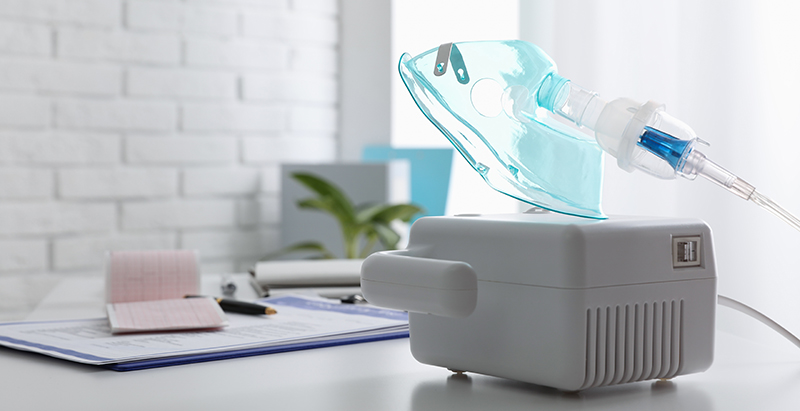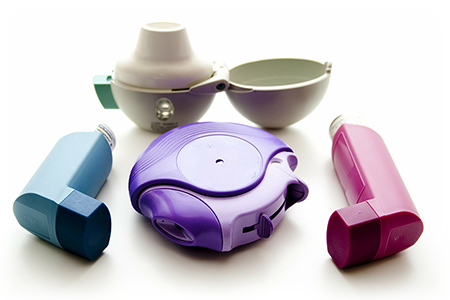Inhaled Medicines
Occasionally, your doctor may prescribe a medicine for you that you will inhale directly into your lungs. There are two main ways to get inhaled drugs into your lungs: nebulizers (nee bue lie zers) and inhalers (also known as puffers).
A nebulizer is a device that changes a liquid medicine into a fine mist. The mist is inhaled into the lungs and distributed in the large and small airways.1 The nebulizer is powered by either an electric source or compressed air. There are several types of nebulizers including jet, ultrasonic (uhl tra sahn ick), and mesh. Jet nebulizers work by using a compressed gas (usually room air) to deliver the medicine. Ultrasonic nebulizers use electric power to create vibrations to turn the medicine into a mist. Mesh nebulizers use a battery or electric power to operate a micropump. This pump pushes the medicine through a fine mesh to create a mist. Mesh nebulizers are almost silent and have shorter treatment times than the other two types.2 Using a nebulizer requires little coordination from you to use. They add moisture to your airways and will take 10-15 minutes to finish.

Inhalers, also known as “puffers,” deliver reliable and consistent doses of inhaled medicines.3 There are three types of inhalers: metered-dose, dry powder, and soft mist. A metered-dose inhaler (MDI) is a small, pressurized canister that fits inside a plastic, boot-shaped holder with an attached mouthpiece. A dry powder inhaler (DPI) contains only powdered medicine. There is no pressurized canister. Soft mist inhalers (SMI) use a spring to release a slow-moving mist when inhaled. Inhalers are portable-- they can fit in your pocket. They are also convenient—it only takes a couple of minutes to deliver a dose. However, they require coordination as well as the ability to breathe in deeply and easily to be useful.

Inhaled Medicines
Below is a list of inhaled medicines delivered by inhaler or nebulizer. These are commonly prescribed to people with bronchiectasis and/or NTM lung disease.
Bronchodilators – Short- and long-acting inhaled bronchodilators (brawn coe die lay tors) may be prescribed to you if you have bronchiectasis and shortness of breath. These drugs can also help relieve the tightening of the airways that can occur when hypertonic saline is used to clear mucus.4 Pulmonary function tests (PFTs) may be ordered to see if bronchodilators would help improve your lung function.3
Hypertonic Saline (hy-per-ton-ick say-lean) –Hypertonic saline used in a nebulizer can help with clearing of the airways.4 To learn about other medicines that may be helpful in thinning and coughing up mucus. Click here.
Antibiotics – Inhaled antibiotics (anty bye ahh ticks) are sometimes used because they are better than oral antibiotics at delivering more of the medicine directly into the airways. The medicine can be inhaled with less of it going into the blood, which can reduce side effects.5,6
Corticosteroids Inhaled corticosteroids (core tee coe stair royds) are usually only helpful to bronchiectasis patients who have another diagnosis like asthma or COPD.7
Using and Cleaning Your Inhaled Medicine Device
It is important to use the right technique when using and cleaning an inhaler or nebulizer. The COPD Foundation has created a video series to show you how to use and clean your nebulizer and/or inhaler.
To view the video series click here.
A reminder from the COPD Foundation: follow the manufacturer’s guidelines for storage, cleaning, and maintaining your inhaled medicine device.
References:
1National Jewish Health. Nebulizers. National Jewish Health website. Published November 1, 2018. Accessed June 17, 2021. https://www.nationaljewish.org/conditions/medications/inhaled-medication-asthma-inhaler-copd-inhaler/nebulizers.
2Ari A. Jet, ultrasonic, and mesh nebulizers: an evaluation of nebulizers for better clinical outcomes. Eurasian J Pulmonol. 2014; 16: 1-7.
3Cleveland Clinic Metered-dose inhaler (MDI). Cleveland Clinic website. Published May 2014. Accessed June 17, 2021. https://my.clevelandclinic.org/health/drugs/8694-inhalers.
4Pasteur MC, Bilton D, Hill AT; British Thoracic Society Bronchiectasis non-CF Guideline Group. British Thoracic Society guideline for non-CF bronchiectasis. Thorax. 2010. ;65 (Suppl 1):i1-i58. doi: https://doi.org/10.1136/thx.2010.136119.
5Chalmers JD, Aliberti S, Blasi F. Management of bronchiectasis in adults. Eur Respir J. 2015 ;45(5):1446-1462. doi: https://doi.org/10.1183/09031936.00119114.
6Xu MJ, Dai B. Inhaled antibiotics therapy for stable non-cystic fibrosis bronchiectasis: a meta-analysis. Ther Adv Respir Dis. 2020; 14:1-14. doi: https://doi.org/10.1177/1753466620936866.
7Yang IA, Clarke MS, Sim EH, Fong KM. Inhaled corticosteroids for stable chronic obstructive pulmonary disease. Cochrane Database Syst Rev. 2012;(7):CD002991. doi: https://doi.org/10.1002/14651858.CD002991.